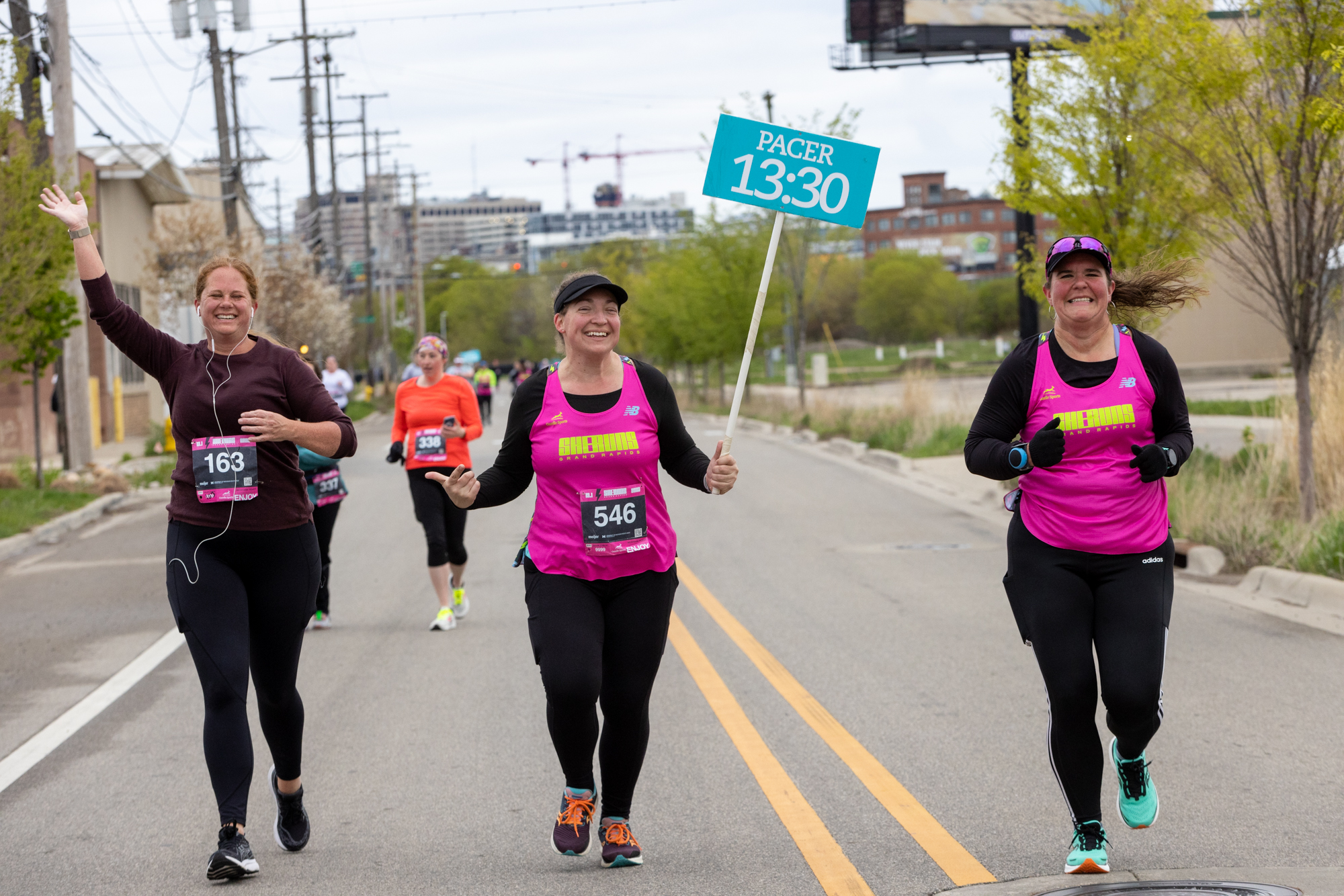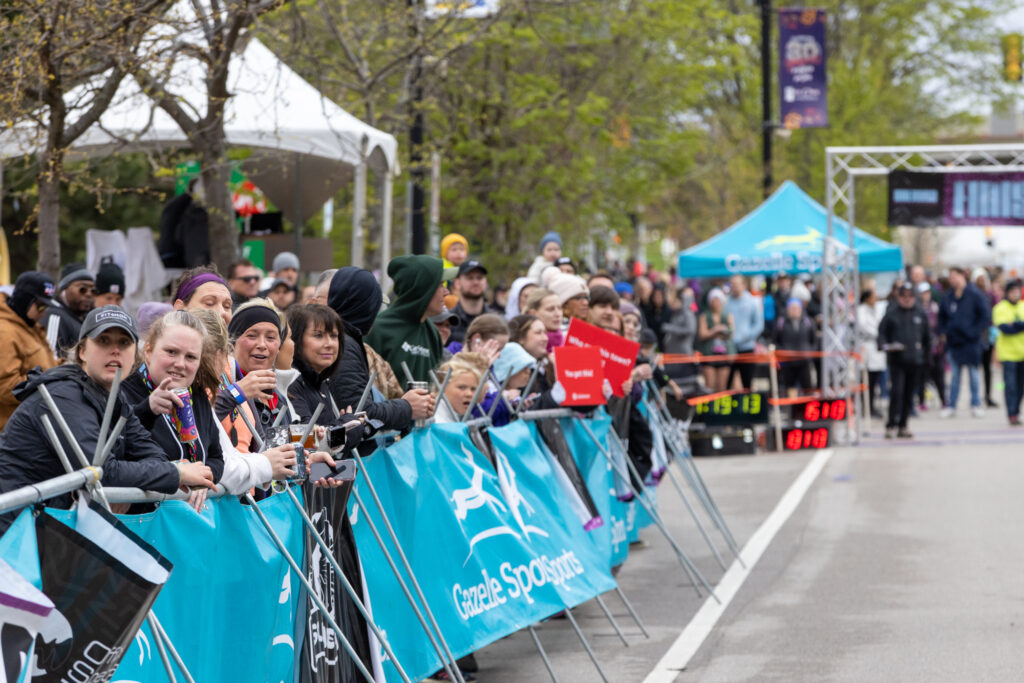
30 Apr Is running with a pace group right for you?
BY ELIZABETH ‘LIZ’ FANCO
As you plan out your summer and fall race calendar, you’ll likely be toeing the line at a road race which has pacers. Usually distinguishable by their brightly colored shirts and their pace signs rising above the sea of runners in the starting corral, pacers can have a pretty significant impact on your race day experience.
Is running with a pace group right for you?
WHY RUN WITH PACERS
Studies have shown that running with a pace group has a measurable impact on the mental load and perceived effort level of an athlete. (Brick et al., 2016) (Bath et al., 2012) . While you may not be running any faster, being able to stick with a group that is all going the same speed makes it FEEL easier than if you are out there running alone. Your cadence tends to fall into rhythm, and you can mentally check-out during those rough miles.
– When running with pacers, you don’t need to be constantly checking your pace on your Garmin, doing runner math, and speeding up or slowing down to hit your desired mile pace by the next marker. Someone else is doing that thinking for you. While running with a pacer likely won’t make you run faster, it will help you be more consistent within your current abilities. (J Sports, 2017)
– When the weather is bad, running with a pace group gives you the chance to experience a bit of drafting. Indy Monumental in 2022 was like running in a wind tunnel, and more and more racers joined the pace groups as they realized they could tuck in and get out of the wind a little bit.
– Your race can be a learning experience! Whether you’re asking for suggestions on how to deal with chafing, nutrition advice, the best pre-run routine, or how to spend the next few days after the race in order to minimize soreness, your pacers are likely to be experienced runners who would love to share their knowledge. Pacers can remind you when it’s time to fuel, help you deal with cramps or blisters, point you in the direction of a good training plan for your next new distance, and answer all those questions you’ve been wondering about, I joke that runners who start and finish a race with me are likely to get 26.2 miles of running coaching!
If you’re considering running with a pace group, here’s some advice to make it the best possible experience:
ASK YOUR QUESTIONS
Most larger races offer you the opportunity to meet the race pacers at the expo – – look for a pacer booth!. For the Grand Rapids Marathon, pacers walk around the expo with their signs, making them easy to find. However, if chatting the day before the race isn’t an option, get to your corral with enough time on race morning to touch base with the pacer for a few minutes. A few questions to ask:
– Pacing Strategy – This is the most important question to ask. Are they running a steady 10:00 mile the entire time? Are they running 3:1 run/walk intervals? Perhaps the course is really hilly at the end, like the Twin Cities Marathon, and they plan to bank some time to keep the effort level consistent when you start climbing elevation. You should know what to expect, whatever the plan.
– Gun Time v Chip Time- Smaller races often have their pacers based on gun time, meaning that they start their watches when the starting horn sounds (regardless of when they cross the start mat). Larger races can take 5-10 minutes or more from the time the gun sounds until you actually cross under the Start banner, and so the pacer time is based on chip time. If you plan to stick with the pacers to hit a certain finish time based on chip time, cross the start line as close to them as you can.
– Aid Station Strategy – Do they run through the aid stations with a steady pace? Bank a little extra time during certain miles to walk all aid stations? If you plan to walk through the water tables and the pacer is running straight, it’s beneficial to run a little ahead to hit the aid station first, take your walk time to consume fluids and nutrition, and then rejoin them as they run through. Playing catch-up when you just swallowed food/liquid is no fun.
– Starting Corral – if the pace group you’re planning to run with is in a different start corral than you, you may need to change your corral. For most races you can move to a SLOWER corral on race day without changing designation, but if you want to move to a FASTER corral you need to do so at the registration/changes table at the expo. Bear in mind that for very large races (like Chicago), there are often multiple groups of pacers running the same finish time but from different corralls. This means the corral in front of you may have a 4:30 marathon group in addition to the 4:30 pacers in your group. On race day, if you come upon a pace group, make sure to verify which corral they started with. A few years ago a friend caught up to the 5:00 pace group in Chicago and ran with them to the finish, thinking she would have her first sub-5:00 marathon, only to discover the 5:00 group she ran with started in the corral 10:00 BEHIND us, giving her a 5:10 marathon.
– What’s Your Pacing Experience? It’s a fair question, and worth asking. For almost all races & pacing companies (like Beast Pacing), a pacer will need to finish within a certain range of their assigned time in order to be invited back to pace again. You can have a fair amount of confidence that an experienced pacer will stick to their plan. This is not to say that first time pacers AREN’T reliable, every pacer had to have an inaugural race, but be a little more conscious of how the race is unfolding when running with a newbie pacer. I’ve had the privilege of running with some AMAZING pacers over the past few years, and some who are absolutely ATROCIOUS. It’s not helpful to run with a pacer who speeds through the first 90% of the race and then walks the last 10% because they weren’t paying attention to their mile splits. I’ve also encountered first time pacers who finish 5, 10, even 20 minutes FASTER than their assigned time, simply because they think their role is simply to ‘beat’ the time on their sign. There’s nothing so frustrating as watching the 2:45 half pacer go speeding past me when I’m pacing 2:30.
– Are You Local/ Have You Run This Course? Races like the Amway Riverbank Run, Grand Rapids Marathon, and LMCU Bridge Run have pacers who return year over year and could practically run those courses blindfolded. They know to give you a heads up about the Butterworth hills and where runners often hit their wall (::cough, cough:: Indian Mounds), and use that knowledge to help guide you through an unfamiliar course. This can have a major impact on your race day experience when the running gets tough. Someone who flew into town and is running the course for the first time right alongside you won’t have this knowledge. Pick their brains- a pacer can tell you more about the course than a Strava elevation chart ever will.
– Tell Them Your WHY As a pacer, I love finding out what inspired a runner to be out there, because I can use it to help keep them motivated during the race. Are they running in honor of someone? Raising money for a cause? Trying to hit a PR? My FAVORITE runners are the ones facing a distance for the first time. Recently at a marathon in Maryland, I encountered a struggling runner who was facing 26.2 miles for the first time. He was under-trained and under-fueled, and so I made a big deal at every aid station of calling out “Hey guys, this is _____, and he’s about to be a FIRST TIME MARATHONER!” The cheers got his adrenaline going and helped keep him moving until we reached each next aid station. Help your pacer help YOU, by giving them a look into why you’re lining up on race day.
WHEN PACERS MIGHT NOT BE A GOOD IDEA
– If you have a specific pacing strategy already in mind which differs from steady miles, it’s best to use the pacers as a rough guide but not run with the group. Whether it’s run/walk intervals, banking time in the first half of the race, or running progressively negative splits, you’re not likely to follow your race plan if you are glued to a pace group running differently.
– If there isn’t a pace group which matches your goal pace you’re going to be tempted to go out too fast or too slow if you run with the closest group. Depending on the size of the race, paces are often broken up in large chunks (separated by 1:00/mile pace for 5k/10k or up to 30 minute increments for full marathons). If you plan to run a 5:15 full, going out with the 5:00 group is likely to burn you out too quickly and you may find yourself back by the 5:30 group before long.
– If you run with a slow cadence it’s really difficult to not fall ‘into step’ if you find yourself in the middle of a group. If the pace lines up with your goals, run just ahead of the group to avoid the unconscious cadence adaptation. Terence Reuben and Dave DaPrato at PT Sports Pro do a great job working with athletes on running a 180 cadence for maximum efficiency, but the time to try out increasing your 155 to 180 is NOT on race day.
– If you’re not a ‘people person,’ then running with a large group can be emotionally draining. If 100% of your training has been you, the open road, earbuds, and an audiobook, being surrounded by high-energy chatting runners may throw you off your game. Don’t be afraid to run YOUR race, how you trained, if you start feeling off.

HAVE A GREAT RACE!
Ultimately, pacers can have a substantial impact on your race day experience, and you can set yourself up to use them most efficiently with a little pre-planning. Running in community is a great way to accomplish your goals leading up to race day, and local organizations like Run GR give you the chance to run with pace groups as you train. Find your people and share some miles, and on race day it will feel like second nature! Some of my best running friends these days are people who once paced me, or who I’ve had the privilege of pacing in races.
And if you’re interested in becoming a pacer, reach out to the Race Director for the races you’re interested in. They will direct you to the Pace Team Coordinator or pacing company, who can let you know of any openings. Pacing is incredibly fulfilling – – getting to be there for the final step of someone’s quest toward a goal, getting to be an advocate and encourager for them on the course, and watching them cross that finish line – – at least for me, that beats a personal PR any day!
About the Author
Elizabeth ‘Liz’ Fanco is a coach in the Grand Rapids area. She has had the opportunity to pace half and full marathons both locally and across the country, and is a fierce advocate for “back of the pack” runners, ensuring that they have the best possible race day experience. She’s also the founder of the Hate Running Less club, which offers group runs with interval training 4 days/week. Liz is a mother of 8, an ‘adult-onset’ runner, and competes every weekend of the year in running or multi-sport events, with a passion to help others achieve their goals.
References
Brick, N.E., Campbell, M.J., Metcalfe, R.S., Mair, J.L, & MacInyre, T.E. (2016). Altering pace control and pace regulation: Attentional focus effects during running. Medicine & Science in Sports & Exercise, 48(5), 879-86. doi: 10.1249/MS.0000000000000843
Bath, D., Turner, L.A., Bosch, A.N., Tucker, R. Lambert, E.V., Thompson, K.G., & St Clair Gibson, (2012). The effect of a second runner on pacing strategy and RPE during a running time trial. International Journal of Sport Physiology Performance, 7(1), 26-32
J Sports Sci Med. 2017 Dec; 16(4): 551–557. 2017 Dec 1. PMCID: PMC5721186, “The Influence of a Pacesetter on Psychological Responses and Pacing Behavior during a 1600 m Run” Christopher L. Fullerton, et al.
Be active!
